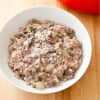Using a Foil Lid When Braising Meat
Some recipes call for placing foil over the surface of braising meat to yield a more tender result. Does this work?
We found reference to the “inverted foil lid” method for braising in Madeleine Kamman’s 1971 classic The Making of a Cook. Once the meat and braising liquid are in the pot, Kamman has you press a sheet of foil directly on top of them and up the sides of the pot before putting on the lid and placing the pot in the oven. The foil lid allegedly increases the pressure, which “bears on the meat fibers and slowly pries them open.” It didn’t seem totally implausible to us. Look at pressure cookers: They have lids with rubber gaskets that prevent steam from escaping, thus increasing pressure inside the pot and raising the boiling point to as much as 250 degrees. So we know that hotter liquid can speed cooking, delivering tender pot roast in an hour or less. Could a mere sheet of foil have a similar effect?
To find out, we braised two pieces of meat of identical weight, using the same pot for the same amount of time, in the same oven, and we used the same amount of liquid, at the same temperature. Before sealing up the pot, we dropped in a gadget that would record the temperature inside the pot every 5 minutes for 2 1/2 hours. When we compared the two, we saw that the pot with the foil lid heated slightly more quickly for the first 40 minutes, averaging 3 to 6 degrees higher than the foil-less pot. But the pots were within 1 degree of each other from the 40-minute mark until the 90-minute mark, when both reached 212 degrees, where they remained for the rest of cooking. The batches of meat were indistinguishable.
THE BOTTOM LINE: Don’t waste your time and foil. Covering the meat with foil does not increase pressure or temperature in the pot or improve the meat.


